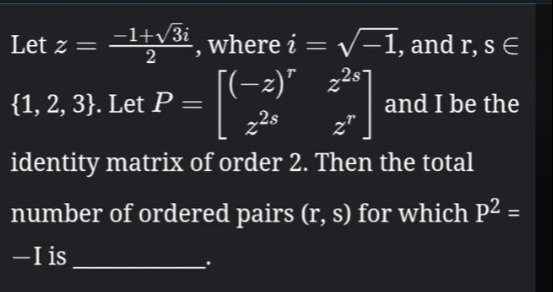Question
Question: Let $z = \frac{-1+\sqrt{3}i}{2}$, where $i = \sqrt{-1}$, and r, s $\in$ {1, 2, 3}. Let $P = \begin{b...
Let z=2−1+3i, where i=−1, and r, s ∈ {1, 2, 3}. Let P=[(−z)rz2sz2szr] and I be the identity matrix of order 2. Then the total number of ordered pairs (r, s) for which P2=−I is ______.

1
Solution
The given complex number is z=2−1+3i. This is the complex cube root of unity, commonly denoted as ω. So, z=ω. The properties of ω are ω3=1 and 1+ω+ω2=0.
The given matrix is P=[(−ω)rω2sω2sωr], where r, s ∈ {1, 2, 3}. We are looking for the ordered pairs (r, s) such that P2=−I, where I=[1001].
Let's compute P2: P2=[(−ω)rω2sω2sωr][(−ω)rω2sω2sωr]=[((−ω)r)2+(ω2s)2ω2s(−ω)r+ωrω2s(−ω)rω2s+ω2sωr(ω2s)2+(ωr)2]
Since (−ω)r=(−1)rωr, we have ((−ω)r)2=((−1)rωr)2=(−1)2rω2r=1⋅ω2r=ω2r. Also, (ω2s)2=ω4s.
The diagonal elements of P2 are ω2r+ω4s. The off-diagonal elements are (−ω)rω2s+ω2sωr=(−1)rωrω2s+ωr+2s=(−1)rωr+2s+ωr+2s=ωr+2s((−1)r+1).
So, P2=[ω2r+ω4sωr+2s((−1)r+1)ωr+2s((−1)r+1)ω2r+ω4s].
We are given P2=−I=[−100−1]. Comparing the elements, we get two equations:
- ω2r+ω4s=−1
- ωr+2s((−1)r+1)=0
Let's analyze the second equation. Since ωk=0 for any integer k, ωr+2s=0. Thus, we must have (−1)r+1=0, which implies (−1)r=−1. This condition holds if and only if r is an odd integer. The possible values for r are {1, 2, 3}. Among these, the odd values are 1 and 3. So, r must be 1 or 3.
Now let's analyze the first equation: ω2r+ω4s=−1. We know that 1+ω+ω2=0, so ω+ω2=−1. The possible values for ωk are 1,ω,ω2 (since ω3=1, ωk=ωk(mod3)). The equation ω2r+ω4s=−1 implies that the two terms ω2r and ω4s must be ω and ω2 in some order. That is, {ω2r,ω4s}={ω,ω2}.
We check the possible values of r (1 and 3) and s (1, 2, 3).
Case 1: r = 1 2r=2(1)=2. So ω2r=ω2. The first equation becomes ω2+ω4s=−1. Since ω2+ω=−1, this requires ω4s=ω. This implies 4s≡1(mod3). Let's test s ∈ {1, 2, 3}:
- If s=1, 4s=4. 4≡1(mod3). So ω4=ω. This works.
- If s=2, 4s=8. 8≡2(mod3). So ω8=ω2. This does not work (ω2+ω2=2ω2=−1).
- If s=3, 4s=12. 12≡0(mod3). So ω12=ω0=1. This does not work (ω2+1=−ω=−1). So, for r=1, the only possible value for s is 1. This gives the ordered pair (1, 1).
Let's verify the pair (1, 1). r=1 is odd, so the second equation is satisfied. For r=1, s=1, ω2r=ω2 and ω4s=ω4=ω. ω2r+ω4s=ω2+ω=−1. The first equation is satisfied. Thus, (1, 1) is a valid pair.
Case 2: r = 3 2r=2(3)=6. So ω2r=ω6=(ω3)2=12=1. The first equation becomes 1+ω4s=−1. This implies ω4s=−2. The possible values for ω4s are 1,ω,ω2. None of these is equal to -2. So, there are no values of s for r=3 that satisfy the first equation.
Therefore, the only ordered pair (r, s) from {1, 2, 3} that satisfies the conditions is (1, 1). The total number of such ordered pairs is 1.
The final answer is 1.
Explanation of the solution:
-
Identify z as the complex cube root of unity ω.
-
Calculate P2 in terms of ω.
-
Equate P2 to −I to obtain a system of equations.
-
Solve the off-diagonal equation: ωr+2s((−1)r+1)=0. Since ωk=0, this implies (−1)r+1=0, so (−1)r=−1. This means r must be odd. Given r ∈{1,2,3}, r must be 1 or 3.
-
Solve the diagonal equation: ω2r+ω4s=−1. Using the property ω+ω2=−1, this equation is satisfied if and only if {ω2r,ω4s}={ω,ω2}.
-
Check the possible values of r (1 and 3) and s (1, 2, 3).
- If r=1, ω2r=ω2. We need ω4s=ω. This requires 4s≡1(mod3). For s ∈{1,2,3}, only s=1 satisfies this. This gives the pair (1, 1).
- If r=3, ω2r=ω6=1. We need 1+ω4s=−1, which means ω4s=−2. No value of ωk is -2, so there are no solutions for r=3.
-
The only valid ordered pair is (1, 1).
-
The total number of ordered pairs is 1.
The final answer is 1.
